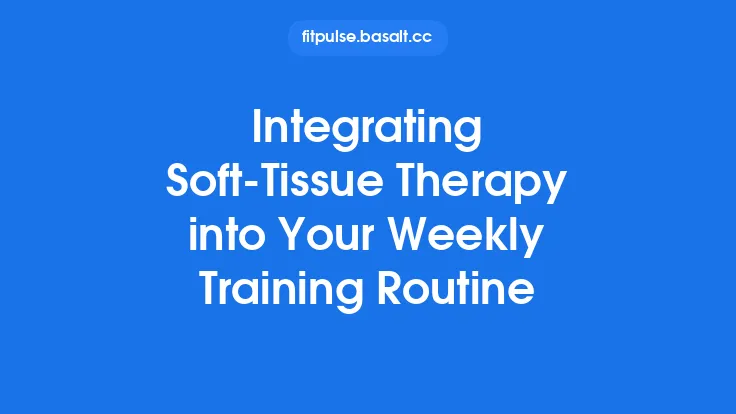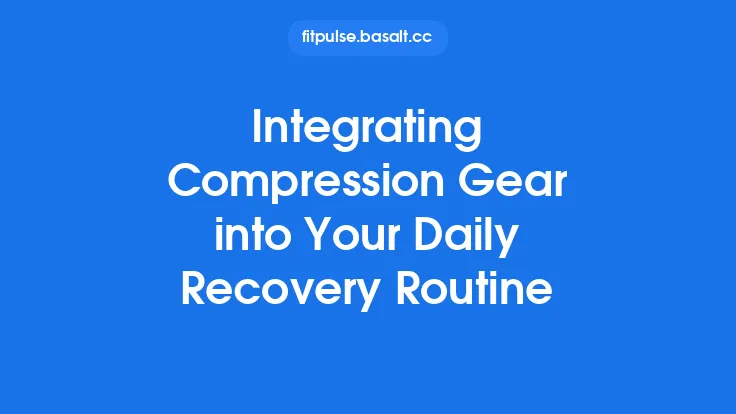Integrating cryotherapy into a regular training regimen can feel like adding a high‑tech secret weapon to your recovery toolbox. When used thoughtfully, the rapid cooling of tissues can accelerate the removal of metabolic waste, blunt excessive inflammation, and even prime the nervous system for the next training session. This article walks you through the science behind cryotherapy, practical ways to weave it into your weekly plan, and the safety measures that keep the benefits outweighing the risks.
Understanding Cryotherapy Modalities
Cryotherapy isn’t a monolith; it spans a spectrum of delivery methods, each with its own temperature range, exposure time, and physiological impact.
| Modality | Typical Temperature | Session Length | Common Settings |
|---|---|---|---|
| Whole‑Body Cryotherapy (WBC) | ‑110 °C to ‑140 °C (‑166 °F to ‑220 °F) | 2–4 minutes | Cryo‑chambers with nitrogen vapor |
| Localized Cryotherapy (Cold Packs, Ice Baths) | 0 °C to 10 °C (32 °F to 50 °F) | 10–20 minutes (ice bath) or 15–30 minutes (packs) | Portable ice tubs, reusable gel packs |
| Cryo‑Massage (Cold Air Jets) | ‑20 °C to ‑30 °C (‑4 °F to ‑22 °F) | 5–15 minutes | Hand‑held devices that spray cold air onto specific muscles |
| Cryo‑Compression (Cold + Pressure) | 5 °C to 15 °C (41 °F to 59 °F) | 10–20 minutes | Devices that combine cooling with pneumatic compression (note: focus remains on the cooling aspect) |
The primary driver of cryotherapy’s effect is the rapid drop in tissue temperature, which triggers vasoconstriction followed by a rebound vasodilation once the cold stimulus is removed. This “vascular pump” helps flush out lactate, inflammatory cytokines, and cellular debris, while delivering oxygen‑rich blood to the same area during the re‑warming phase.
How Cryotherapy Enhances Training Adaptations
- Reduced Delayed‑Onset Muscle Soreness (DOMS)
By limiting the magnitude of the inflammatory cascade, cryotherapy can blunt the intensity of DOMS, allowing athletes to train more frequently without compromising technique.
- Improved Neuromuscular Function
Cold exposure temporarily reduces nerve conduction velocity, which can be leveraged to “reset” over‑active motor units. When the tissue re‑warms, there’s often a brief window of heightened proprioceptive acuity and muscle recruitment efficiency.
- Hormonal Modulation
Acute cryotherapy sessions have been shown to increase circulating norepinephrine and β‑endorphins, contributing to a feeling of alertness and reduced perception of pain—both valuable for high‑intensity training days.
- Enhanced Sleep Quality
A post‑exercise cryotherapy session can lower core body temperature, a key signal for the onset of sleep. Better sleep translates to improved glycogen restoration and muscle protein synthesis.
Practical Ways to Incorporate Cryotherapy Into Your Routine
1. Scheduled Weekly Sessions
- Beginner Plan: 1–2 WBC sessions per week (3 minutes each) on non‑consecutive days.
- Intermediate Plan: 2–3 sessions per week, alternating between WBC and a 10‑minute ice bath after heavy leg days.
- Advanced Plan: 3–4 sessions per week, integrating localized cryo‑massage on specific sore spots after each training block.
2. Post‑Workout Cryotherapy
- Ice Bath Protocol: Fill a tub with water at 8 °C–10 °C (46 °F–50 °F). Submerge up to the waist for 10 minutes, focusing on the muscle groups that were heavily taxed. Add a small amount of sea salt to improve conductivity and reduce skin irritation.
- Cold Pack Rotation: Apply a reusable gel pack to the quadriceps, hamstrings, or shoulders for 15 minutes, then remove for 5 minutes. Repeat for a total of 30 minutes if soreness persists.
3. Pre‑Workout Cryotherapy (Priming)
- Brief Cryo‑Massage: Use a handheld cold‑air device for 5 minutes on the target muscle group 30 minutes before a power‑lifting session. The brief vasoconstriction followed by rapid re‑warming can increase muscle fiber recruitment during the lift.
- Contrast‑Free Cold Exposure: A 2‑minute exposure to a cryo‑chamber (‑130 °C) can stimulate the sympathetic nervous system, sharpening focus and reaction time.
4. Recovery Days
- Full‑Body Sessions: On active recovery days, a 3‑minute WBC session can serve as a low‑impact “active rest,” promoting circulation without adding mechanical stress.
- Localized Cryo‑Compression: If you have a device that combines cold with gentle pressure, use it for 10 minutes on any lingering tightness after a yoga or mobility session.
Timing Strategies: Pre‑ vs Post‑Workout Cryotherapy
| Goal | Recommended Timing | Rationale |
|---|---|---|
| Acute Inflammation Control | Immediately post‑exercise (within 30 min) | Maximizes the vasoconstriction‑vasodilation cycle, flushing metabolites before they settle. |
| Performance Priming | 30–60 min before training | Brief cold exposure can increase catecholamine release, enhancing power output and mental alertness. |
| Sleep Enhancement | 1–2 hours before bedtime | Lowering core temperature supports melatonin secretion and deeper sleep stages. |
| Long‑Term Adaptation (Strength/Hypertrophy) | Use sparingly post‑heavy sessions; avoid daily exposure | Excessive suppression of inflammation may blunt the signaling needed for muscle growth. |
A balanced approach often involves a pre‑session “priming” cryo‑massage followed by a post‑session ice bath on the most demanding training days, while reserving full‑body cryotherapy for recovery or rest days.
Safety First: Contraindications and Precautions
- Medical Conditions Requiring Clearance
- Cardiovascular disease (e.g., uncontrolled hypertension, recent myocardial infarction)
- Raynaud’s phenomenon or severe peripheral vascular disease
- Cold urticaria (allergic reaction to cold)
- Pregnancy (especially first trimester)
- Skin Integrity
- Avoid applying ice or cold packs directly on open wounds, abrasions, or areas with reduced sensation (e.g., diabetic neuropathy). Use a thin barrier (towel or cloth) to prevent frostbite.
- Exposure Limits
- Whole‑Body Cryotherapy: Do not exceed 4 minutes per session. Exceeding this can lead to hypothermia, respiratory irritation from nitrogen vapor, or loss of consciousness.
- Ice Baths: Keep water temperature above 0 °C (32 °F) to prevent severe tissue damage. Monitor for signs of numbness or tingling beyond the normal “cold” sensation.
- Gradual Acclimatization
- Start with shorter exposures (1–2 minutes for WBC, 5 minutes for ice baths) and incrementally increase as tolerance builds. This reduces the risk of sudden blood pressure spikes.
- Hydration and Electrolyte Balance
- Cold exposure can increase diuresis. Ensure adequate fluid intake before and after sessions, especially if combined with intense training.
- Monitoring Tools
- Thermometer: Verify water or chamber temperature before each session.
- Heart Rate Monitor: Track resting heart rate before and after cryotherapy; a significant drop may indicate excessive vagal stimulation.
- Skin Temperature Sensors: For athletes with a history of cold sensitivity, these can provide real‑time feedback to avoid frostbite.
Monitoring Progress and Adjusting Protocols
- Subjective Metrics: Keep a training log that includes perceived soreness (0–10 scale), sleep quality, and mood after each cryotherapy session.
- Objective Measures: Periodically assess performance markers (e.g., squat 1RM, sprint times) to ensure cryotherapy isn’t dampening training adaptations.
- Recovery Biomarkers: If resources allow, track creatine kinase (CK) levels or inflammatory markers (e.g., IL‑6) pre‑ and post‑intervention to quantify physiological impact.
- Periodization: Align cryotherapy intensity with your training macro‑cycle. During hypertrophy phases, limit post‑session cryotherapy to 1–2 times per week; during endurance or skill phases, you can increase frequency to support higher training volumes.
Frequently Asked Questions
Q: Can I combine cryotherapy with other recovery modalities?
A: Yes, but prioritize one primary method per session to avoid conflicting signals. For example, follow a WBC session with gentle stretching, but avoid immediate hot‑water immersion, which can counteract the vasoconstriction benefits.
Q: How long does the “pain‑blunting” effect last?
A: The analgesic effect typically peaks within 30 minutes and can linger for 2–3 hours, depending on exposure length and individual sensitivity.
Q: Is cryotherapy suitable for beginners?
A: Absolutely, provided they start with low‑intensity protocols (shorter exposure, higher temperatures) and obtain medical clearance if any health concerns exist.
Q: Do I need special equipment for home use?
A: A high‑quality ice bath tub or a set of reusable gel packs can deliver most of the benefits. For whole‑body cryotherapy, a commercial chamber is required, but many gyms now offer membership‑based access.
Putting It All Together
Integrating cryotherapy into your training routine is less about a one‑size‑fits‑all prescription and more about tailoring exposure to your specific goals, training load, and physiological response. By:
- Choosing the right modality for the day’s demands,
- Timing the exposure to either prime performance or accelerate recovery,
- Observing safety guidelines and respecting personal contraindications,
- Tracking outcomes and adjusting protocols as you progress,
you can harness the cold to keep muscles resilient, nerves sharp, and recovery cycles efficient. When applied judiciously, cryotherapy becomes a strategic ally—helping you train harder, recover faster, and stay consistent on the path to long‑term performance gains.





